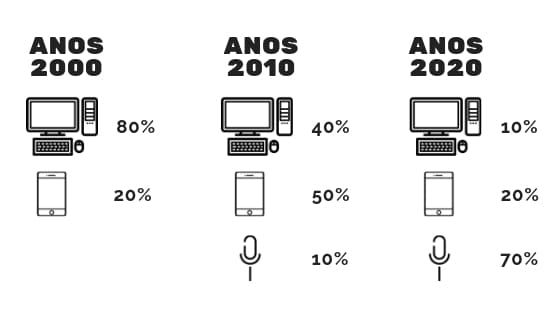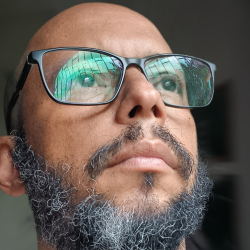AEO is the new SEO.
SEO has been in constant flux since its inception. Today, there's a lot of talk about SEO and AEO, with the latter being a natural evolution of the former. Search engine optimization is naturally evolving into voice search optimization.
As companies expand their fields of study (Artificial Intelligence, "Machines that learn") and new generations adopt these new ways of seeking what they want, we professionals have to update ourselves, test, and apply them to our projects.
To try and understand this scenario, in this article we will analyze these four points:
- Define what AEO : Answer Engine Optimization;
- Let's talk about the evolution of search engines into question-answering machines;
- Describe the evolution of SEO as a business strategy ;
- To point out some paths that AEO will lead us down.
AEO: Answer Engine Optimization
In plain English: Optimization for Response Mechanisms
With the rise of voice search, Google and other companies, such as Bing and Amazon, are increasingly relying on their voice understanding search results . Understanding and credibility are fundamental factors in providing a unique solution for those searching.
The voice is naturally more detailed, more natural… and ultimately requires a single response.
In this type of search, there is only one answer and one chance to please the consumer.
What is AEO?
Answer Engine Optimization (EEG) is a set of techniques that optimizes content user questions .
Search engines are becoming question-answering machines.
The evolution of SEO in AEO

In the 2000s, 80% of searches were done on computers and only 20% on mobile devices. By the 2010s, 50% of searches were already done on smartphones, compared to 40% on desktops, and voice searches appeared for the first time, accounting for 10%.
The projection for 2020 is that this scenario will change radically, with 70% of searches being done by voice.
Therefore, SEO must transform into AEO.
The evolution of search engines
From search engine to answer engine
History of the Web tells us , information was scattered across a semi-connected network of pages . And then the search engine emerged. And it called itself Google .
Our goal is to organize all the information in the world.

And with it came SEO: a series of crazy strategies that made websites appear in the top positions of that site which, with a small search field
Time passed, other companies emerged, most no longer exist. Giants like Amazon and Microsoft also have their search engines, with relative success.
Apple, due to the launch of the iPhone, entered this battle with its system, and even facing problems, they continue to evolve.
Nowadays, new technologies, mostly developed by Google, have completely changed the search .
Nowadays, to rank higher on Google , you need to pay attention to what people are saying.
A new business strategy for AEO
A good portion of businesses already understand the importance of SEO. A fraction of them apply the best techniques and achieve success over time. If your company is in this select group: Congratulations!
But then I ask you a question: How will you maintain the success of your website if people don't even visit it anymore? If people get the answers they need directly from a question answered by Google, right in the search ?
A tip: don't despair, there are ways to do this. I've prepared two pieces of content:
What will SEO be like in the future? and How to rank on Google in 2019 .
How will your company adapt to this new scenario?
But the landscape presents a challenge for large business groups that have not yet managed to leverage SEO , Content Marketing , Inbound Digital Marketing strategies :
How do you transition directly from offline, interruption-based marketing to cutting-edge technology-based marketing?
If you feel you should do this, contact me and I can help you.
Paths to where AEO will take us
When such a radical change is implemented, we need to take a step back and look at the bigger picture.
What possibilities and challenges does voice search optimization present?
The first challenge/opportunity is attracting new users.
According to data from the IBGE's Continuous National Household Sample Survey (PNAD C) of 2016, Brazilians who are online make up 64.7% of the entire population .
According to the same research, the age group, individuals between 18 and 24 years old, had the highest connection rate: 85% .
Brazilians over 60 years old had the lowest rate, at 25%.
The opportunity is clear: we have a huge number of people who need and want access to online , but who are currently excluded from this market.
Google Lens Text-to-Speech
At Google I/O 2019, during the presentation of Google Lens for Google Go (the search app for simpler devices), the company revealed that the app will be able to read any text aloud and even translate it into the user's native language.
The app is very lightweight, which allows it to be included on very inexpensive mobile phones.
Google gave a practical example of what this can mean for people who have difficulty reading.
In the video example, the mother is helped by the search function because she cannot read. This is also a reality in our country. But imagine how this same functionality could help someone who no longer sees as well as they used to, or who has trouble typing on a device with a screen with small letters and buttons?
Your most loyal customer may be 60 years old or older and have trouble finding your products. They'll love you if you solve that problem with technology.
Now think about your business: how will voice search technology impact it? How will you solve the new problems with services and products?
If you want, leave a comment below and I'll reply.





Post comment